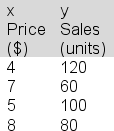Multiple Choice
The following data have been collected for a simple linear regression analysis relating sales (y) to price (x) :  In applying the least squares criterion, the slope (b) and the intercept (a) for the best-fitting line are b = -12 and a = 162.You are to conduct a hypothesis test to determine whether you can reject the null hypothesis that the population slope, β, is 0 at the 1% significance level.Compute the value of the sample test statistic, tstat, and use it to reach the proper conclusion.
In applying the least squares criterion, the slope (b) and the intercept (a) for the best-fitting line are b = -12 and a = 162.You are to conduct a hypothesis test to determine whether you can reject the null hypothesis that the population slope, β, is 0 at the 1% significance level.Compute the value of the sample test statistic, tstat, and use it to reach the proper conclusion.
A) Since tstat is inside the critical ±9.925 boundaries, we can't reject the β = 0 null hypothesis.
B) Since tstat is outside the critical ±9.925 boundaries, we can reject the β = 0 null hypothesis.
C) Since tstat is inside the critical ±7.845 boundaries, we can't reject the β = 0 null hypothesis.
D) Since tstat is inside the critical ±7.845 boundaries, we can reject the β = 0 null hypothesis.
Correct Answer:

Verified
Correct Answer:
Verified
Q101: The following data have been collected for
Q102: The manager of a local shopping mall
Q103: Application of the least squares criterion to
Q104: A procedure used for finding the equation
Q105: The following data have been collected for
Q106: Which of the following best describes the
Q107: A procedure used for finding the equation
Q108: Suppose a rental car company uses simple
Q109: The standard error of estimate (s<sub>y.x</sub>) in
Q110: Economist Joshua Grant is using linear regression